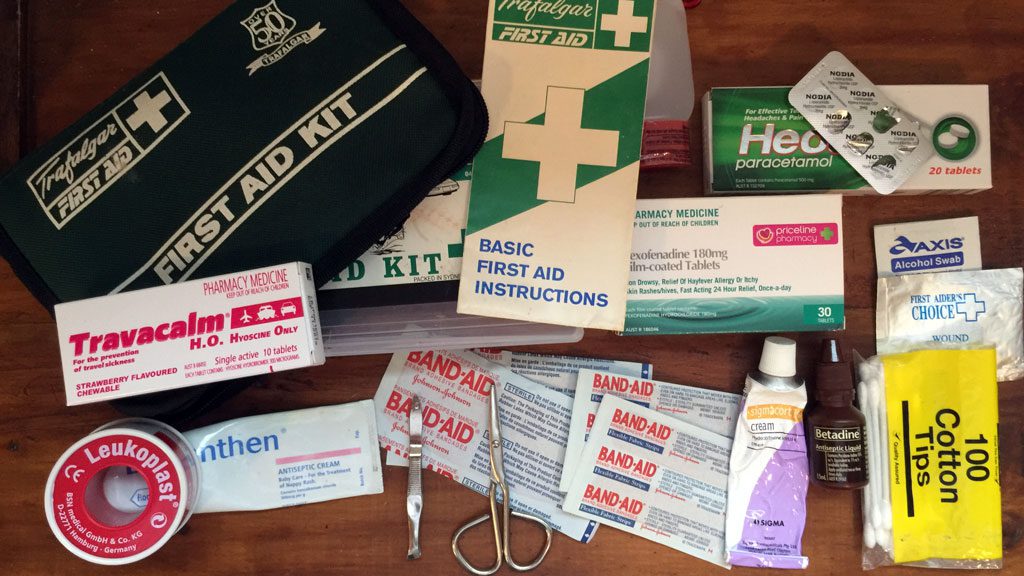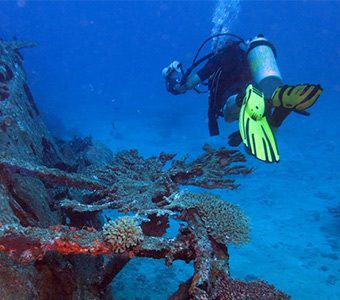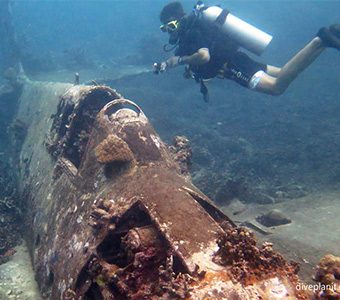OK, so you’re in a hurry, you’re leaving tomorrow for a once in a lifetime dive trip, and your buddy’s asking _you_(!) to pack the diving first aid kit. You want a list to take to the pharmacy right now – here’s what we take: (and below – we explain why)
- Diarrhea Relief
- Antihistamine
- Motion Sickness tablets
- Paracetamol
- After sun cream
- Electrolyte Rehydration Powder
- Hand sanitiser
- Antiseptic wipes
- Antiseptic Cream
- Couple of small and BIG water proof plasters (or better, 3”x3” sterile dressings and some tape and something like nail scissors to cut it)
- A pack or box to keep it all in (a Tupperware box will do nicely), preferably with ‘FIRST AID’ written on it.
If you buy in bulk and take just a few of each type of tablets be sure to label them – preferably in their original blister packs – packets of little white tablets in your luggage will attract the attention of customs officers …
Obviously prevention is better than cure, so take sunscreen and mozzie repellent of the appropriate strength in both cases.
It can get expensive buying little packets of things, so you would do well to buy a general first aid kit, remove all the triangular bandages ( – give them to your kids to play doctors and nurses), and replace with the essential grown-up items. Added advantage is that you get a nicely labelled box or pack and hopefully some first aid instructions.
Rationale
What we’re describing here is a personal scuba diving first aid kit – so you can tend to the minor ailments that often occur whilst diving – especially when away from home. Our rationale is to minimise the distractions so you can focus on your dive – and not just that you are in the right frame of mind to enjoy your dive – but also free from distractions to concentrate on the things that matter: gear setup, buddy checks, remembering the dive brief, what is your computer telling you. Here’s a bit more detail on each component.
Diarrhea Relief
Diving often means we are away from ‘facilities’ for much of the day, and though we’d all like to think the operator we have chosen couldn’t possibly have hygiene issues, in some places you can get a touch of ‘gastro’ just by breathing. So, better safe than sorry. But note, that something like Imodium is just a cork; it will help you get through the diving day without embarrassing yourself, but it does not cure you of the internal issue.
Motion Sickness
So obvious – they’re often forgotten – and it’s easy to go through a whole pack in one trip and forget to replace them. Different brands cause different levels of drowsiness in different people. Nowadays there are all sorts of ear plugs and ‘behind the ear’ patches too. (I know what works for me).
Antihistamine
We’re not suggesting you’re going to get hay fever underwater – though if you’re travelling to the opposite hemisphere – the season at your destination might just give you hay fever. This is more for itchy skin or a rash caused by an accidental brush with the wrong marine creatures. Fexofenadine is a fast-acting, non-drowsy, medication that does the trick for most people. The alternate is an antihistamine (or even a hydrocortisone) cream if you’re not at all predisposed to hay fever, but just want something for a potential skin rash.
Paracetamol
Universal pain relief with the benefit over ibuprofen that it also helps reduce fever and is gentler on the stomach. Though if you find aspirin or ibuprofen works infinitely better for you – your call.
Electrolyte Rehydration Powder
If you drink plenty of water you should be OK. But note that to stay hydrated it’s best to drink small amounts frequently (20ml per 20 minutes is the absolute optimum – apparently – though probably not practically). Waiting until you’re gagging of thirst, then drinking a litre of water (and pissing a litre of water) is called ‘flushing’ and does not count towards sensible hydration.
If you do get dehydrated, you can lose essential minerals and salts and can become groggy and confused. That’s where the electrolytes come in. Another advantage of having some flavoured powder is that if the water you’re provided is ‘perfectly safe to drink’ – but tastes like the inside of Tutankhamen’s tomb, you can turn something that’s drinkable into something that’s palatable.
After sun
It happens. We all forget that the sun over there is different from the sun over here – and it reflects off the water and gets you where you least expect it. And invariably it’ll get you just where the wetsuit rubs. Aloe Vera or Pawpaw cream works well.
And now – the dressings
Now we’re into the boy scouts’ stuff. If you get a cut, bite, deep scratch, you should be able to deal with it yourself, rather than relying on the operator’s big medical kit for help.
So you should be able to clean your hands, clean a small wound, apply some antiseptic and seal the wound with a sterile dressing. That’s ‘first aid’ – and will hopefully keep you diving. For anything more serious, the operator, liveaboard, or resort should have a more serious medical kit for dealing with more serious injuries.
Hand sanitiser is a useful thing to have anyway, especially if you have to use facilities that are less than ideal. Antiseptic wipes and Antiseptic Cream are essential even in a household/car first aid kit. If you’re taking liquid Betadine make sure you have something like cotton buds to apply it with.
Some plasters (or ‘Band-Aids’) are so sticky you can’t get them off or they double as epilation strips; others are so unsticky they fall off of their own volition. Skin that is wet, or has been wet for a while, is notoriously plaster-resistant; so let it dry out first.
Alternately use the tape, and wrap it around your finger/arm/leg/head and overlap it so it can stick onto itself. (And as most parts of the body taper slightly – stick it on to a bit of skin too or it will simply slide down off the wound). Don’t kid yourself you can tear that tape – take nail scissors or similar; and while you’re at it, throw in some tweezers – really useful for pulling out splinters, urchin spikes, bits of jellyfish etc.
Anything more serious than this, is beyond ‘personal first aid’. If you have anything more serious, or are anxious about your condition – seek medical help. Anxiety kills concentration – and therefore your ability to dive safely.
All good to go?
Unfortunately, everything has an expiry date nowadays including medications and even dressings. But like most foods, they don’t turn to poison the instant the clock rolls over midnight on the expiry date – they simply become less effective – some more quickly than others. Also, new and better medications become available – so periodically review you first aid kit.
Another sensible suggestion: go on a first aid course. If you work in corporate, you can often get a free course if you volunteer as the floor’s Fire Warden or some such.
Finally – Full disclosure: the author of this blog has no formal medical qualifications whatsoever, just 37 years of diving experience around the world. You personally must take responsibility for your health when travelling and diving. In addition to your $30 personal first aid kit, you should ensure that your dive operator has both a $300 first aid kit and medical oxygen, and finally that you have medivac insurance to save yourself the $30,000 medical evacuation costs if something serious happens.
Globally DAN responds to over 3,000 calls per annum. Obviously only a few of those result in medivac situations, but it is a fact that in most cases, divers with DCI have, just like you, dived within the safe limits prescribed by their trusty dive computers. Think about it – and you can sign up here.
Sharing is caring – so if you think we’ve missed anything essential – or have any better suggestions – please just add a comment below. Other divers will thank you for it.





Great post – I’ve found that some type of training in First Aid is a great addition to the kit as well…should be easy enough to find community level training on treating ailments like heat exhaustion, heat stress or different levels of shock. After all, knowledge is power! Great starter kit though!